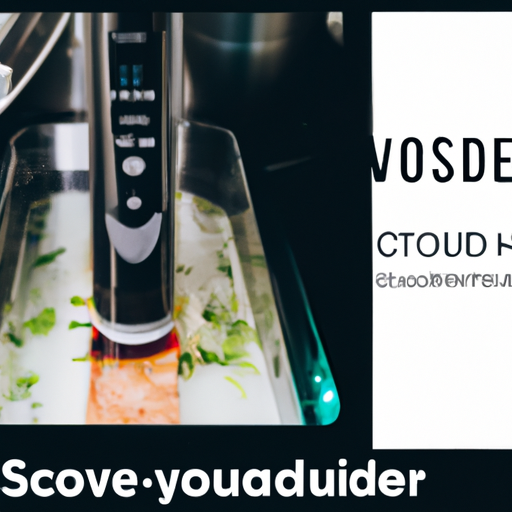Are you tired of guessing cooking times and temperatures when using sous vide to prepare your meals? Look no further! With the Ultimate Sous Vide Cooking Chart, you can say goodbye to overcooked or undercooked dishes. This free PDF download provides you with a comprehensive guide to perfectly cooked meats, seafood, and vegetables every time. Whether you’re a seasoned sous vide chef or just starting out, this cooking chart will revolutionize the way you cook. Say goodbye to uncertainty and hello to delicious, restaurant-quality meals in your own kitchen.
Temperature and Time
In the world of cooking, temperature and time play a crucial role in ensuring that your dishes turn out perfectly. Whether you’re cooking meat, seafood, vegetables, or even desserts, understanding the ideal temperature ranges and cooking times is key to achieving incredible flavors and textures. In this article, we’ll explore the general temperature guidelines, temperature ranges by food type, and cooking times by food type to help you become a master in the kitchen.

General Temperature Guidelines
When it comes to cooking, it’s important to know the basic temperature guidelines to ensure food safety. The United States Department of Agriculture (USDA) recommends cooking most meats and poultry to a minimum internal temperature of 145°F (63°C) to kill any harmful bacteria. However, some people may prefer their meat cooked to different levels of doneness, so we’ll further explore temperature ranges for different food types in the following sections.

Temperature Ranges by Food Type
Meat
- Beef: Whether you prefer your steak rare, medium-rare, medium, or well-done, the temperature ranges from 125°F (52°C) for rare to 160°F (71°C) for well-done. Keep in mind that these temperatures vary depending on the cut and thickness of the beef.
- Pork: To ensure safety, pork should be cooked to a minimum internal temperature of 145°F (63°C). However, for a tender and juicy pork, many chefs recommend cooking it to an internal temperature of 160°F (71°C).
- Poultry: Chicken and turkey must always be cooked to an internal temperature of 165°F (74°C) to eliminate any bacteria and ensure food safety.
- Lamb: Similar to beef, the desired doneness of lamb can vary from medium-rare to well-done, with internal temperatures ranging from 125°F (52°C) to 160°F (71°C).
- Veal: For veal, the temperature ranges are similar to beef, with rare veal at 125°F (52°C) and well-done at 160°F (71°C).
Seafood
- Fish: The ideal internal temperature for fish varies depending on the type and thickness, but a good rule of thumb is to cook fish to 145°F (63°C) to ensure it’s cooked through and safe to eat.
- Shellfish: Whether you’re enjoying scallops, shrimp, or lobster, cooking shellfish to an internal temperature of 145°F (63°C) ensures they are safe to consume.
Poultry
- Chicken: As mentioned earlier, chicken should always be cooked to an internal temperature of 165°F (74°C) for food safety.
- Turkey: Whether you’re roasting a whole turkey or cooking turkey breast, the internal temperature must reach 165°F (74°C) to ensure it’s fully cooked and safe to eat.
- Duck: For a succulent and tender duck, the internal temperature should be around 165°F (74°C).
Eggs
- Soft Boiled Eggs: To achieve a perfectly soft-boiled egg with a runny yolk, cook it for approximately 6 to 7 minutes in boiling water.
- Hard Boiled Eggs: If you prefer your eggs hard-boiled, cook them for about 10 to 12 minutes in boiling water.
- Poached Eggs: Poaching eggs requires bringing a pot of water to a gentle simmer, then carefully cracking the eggs into the water and cooking for around 3 to 4 minutes for a slightly runny yolk.
Vegetables
- Root Vegetables: Root vegetables such as carrots, potatoes, and beets are best cooked at temperatures ranging from 190°F (88°C) to 205°F (96°C) to achieve a tender texture.
- Leafy Greens: When cooking leafy greens like spinach or kale, a quick sauté at medium-high heat for a few minutes is all it takes to bring out their vibrant flavors.
- Cruciferous Vegetables: Broccoli, cauliflower, and Brussels sprouts are delicious when roasted at around 400°F (204°C) until they are caramelized and slightly crispy.
- Other Vegetables: Asparagus, green beans, and zucchini can be steamed, sautéed, or roasted at temperatures ranging from 350°F (177°C) to 400°F (204°C) depending on your desired texture.
Fruits
- Soft Fruits: Soft fruits such as berries, peaches, and plums can be enjoyed raw or lightly cooked at around 120°F (49°C) to 140°F (60°C) to release their natural juices and enhance their flavors.
- Hard Fruits: Apples and pears are delicious when baked at temperatures ranging from 375°F (190°C) to 400°F (204°C) until they become tender and caramelized.
Sauces
- Hollandaise Sauce: This classic sauce is often served with eggs Benedict and requires gentle cooking at a low temperature, around 135°F (57°C), to emulsify the egg yolks and butter.
- Béarnaise Sauce: Similar to hollandaise, béarnaise sauce is made by emulsifying egg yolks and butter. The temperature should be maintained at around 135°F (57°C) for a smooth and creamy consistency.
- Butter Sauce: Butter sauce, also known as a beurre blanc, is created by melting butter with white wine and vinegar. It should be cooked at a temperature of around 140°F (60°C) to achieve the perfect balance of richness and acidity.
- BBQ Sauce: While BBQ sauce is not typically cooked to a specific temperature, it’s important to simmer it on low heat for at least 20 to 30 minutes to allow the flavors to meld and thicken.
Desserts
- Custards: Custards such as crème brûlée or flan are traditionally cooked in a water bath at a low temperature, around 160°F (71°C), to achieve a smooth and silky texture.
- Cheesecakes: Baking cheesecakes at a low temperature of around 325°F (163°C) ensures that they cook evenly without cracking.
- Crème Brulee: This delicious dessert is also traditionally cooked at a low temperature, around 160°F (71°C), to achieve a creamy texture before being finished under a hot broiler to caramelize the sugar topping.
- Fruit Compotes: Whether you’re cooking apples, berries, or stone fruits for a compote, simmering them at a low temperature of around 180°F (82°C) helps soften the fruit and allow the flavors to meld together.
Beverages
- Infusions: When creating infused beverages such as herbal teas or flavored spirits, it’s best to steep the ingredients in hot water or alcohol at temperatures ranging from 140°F (60°C) to 180°F (82°C) to extract the desired flavors.
- Flavored Waters: Infusing water with fruits, herbs, or vegetables can be done by soaking the ingredients in cold water for a few hours or overnight, allowing the flavors to infuse naturally.
Understanding the ideal temperatures and cooking times for different food types is essential for creating amazing dishes. Whether you’re a novice home cook or a seasoned culinary enthusiast, this comprehensive guide will assist you in achieving perfect results every time. Remember to always use a reliable food thermometer to ensure food safety and to adjust cooking times based on the size and thickness of your ingredients. Here’s to exploring the endless possibilities of cooking with temperature and time!
